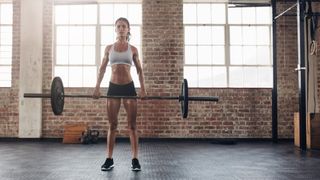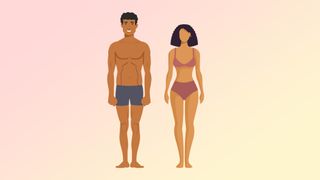The best exercises for people with a mesomorph body type
If you build muscle easily, these are the best exercises for you

If your body type — also known as your somatotype — is a mesomorph, then there are certain exercise hacks that can support your fitness and weight loss goals. In fact, the best exercises for mesomorphs will be a little different from the best exercises for endomorphs or ectomorphs, as your natural body type will respond to exercise differently.
Not sure which body type you are? Here's the difference between an endomorph, ectomorph, and mesomorph. If you’re a mesomorph, you’ll tend to put on muscle easily, and will have more muscle mass than body fat. A gymnast for example could be classed as a mesomorph, as could a rugby player and of course, bodybuilders.
“Mesomorphs will typically be strong and well built,” says Personal Trainer, Aimee Victoria Long, adding that it’s a lot easier to use a workout program and nutrition plan to achieve a mesomorph’s goals.
So what are the best types of exercises for mesomorphs?
Aimee explains that this body type will be able to use heavier weights than an ectomorph, (who typically has a skinnier frame), providing more stimulus for muscle growth.
“If you’re a mesomorph you can switch up your training style more often and include a lot of variety. This can range from using compound lifts such as deadlifts and squats to isolating lifts such as bicep curls. Mesomorphs can also afford to do more functional and conditioning work compared to an ectomorph who needs to keep their calorie surplus as great as possible to aid their results.”
Aimee also adds that High-Intensity Interval Training (HIIT) training is a great option for mesomorphs. This is particularly prevalent for mesomorphs who might be trying to lose unwanted weight as studies have proven how HIIT is more efficient at burning fat than steady-state cardio. HIIT involves a period of all-out work, followed by a short rest. This is repeated as many times as desired.

Diet, fitness, and recovery tips for mesomorphs
Thanks to a relatively high muscle mass, mesomorphs don’t need to worry too much about what they eat.
Sign up to get the BEST of Tom’s Guide direct to your inbox.
Upgrade your life with a daily dose of the biggest tech news, lifestyle hacks and our curated analysis. Be the first to know about cutting-edge gadgets and the hottest deals.
When it comes to weight loss, Aimee explains that a mesomorph “will tend to see results a lot quicker than other body types as they already have a good basis for building muscle or losing body fat”.
Wanting to shed some weight? Aimee adds: “A mesomorph can eat at maintenance calories and possibly in a slight calorie deficit if they are looking to lean up a little.” Using a food tracker can be a good way of assessing calorie intake and making some calorie tweaks for weight loss.
As for recovery between workouts, be sure to incorporate rest days into your regime. Muscles need the rest to recover; it’s during this rest that they grow, so don’t assume that working out every single day will help with weight loss and muscle growth, as it could in fact have the opposite effect.

The best exercises for mesomorphs
Try including these into your workout regime, aiming for three sets of each movement, with each set being made of six to eight reps. For moves that are one-sided, such as the split squats, be sure to do the allocated reps on each side.
Use a challenging weight, to ensure that the last rep or two of each set is a struggle; essentially, you shouldn’t be able to add more reps. If you can, then increase the weight, ensuring that your form is still on point too.
Bench press
Lie back on a flat bench, feet flat on the floor, and hold a barbell right above your shoulders, with hands just a touch wider than shoulder-width apart. You may need a spotter or a rack for this move, especially if you’re using a heavier weight.
Engage your core and lower the bar down to your chest. Pause, then slowly press the bar back up. As you do this move, make sure your hips stay on the bench and try to avoid your back arching, as this can lead to injury.
Pull-ups
Place your hands in an overhand grip position on a pull-up bar, with hands a little wider than shoulder-width apart. Engage your core and aim to keep your body straight, as you use your arms and back to pull yourself up, bending your elbows as you do so. The aim is to pull yourself up to the point where your chin is above the bar. Then slowly lower back down.
Struggling? This is a tough move, so fear not! Try placing one foot in a resistance band to make this move a little easier, or start off on a pull-up machine.
Split squats
Place a barbell across your back, keep your core engaged, and back flat with your gaze forwards. Step your left foot back, as far as it takes so that it’s just your left toes supporting you, with your left heel unable to step down. Your front right foot should be flat on the ground.
This is the position you’ll maintain for the duration of six to eight reps before swapping feet.
Drop down, so that the front right knee and left back knee bend and your body lowers to the ground. Stop when your back knee is just hovering above the floor. Then push up through the front heel to rise. Once you’ve done your reps on one side, swap over.
Walking lunges
For this, you can use a barbell across your upper back, or hold a dumbbell on each shoulder. Stand upright, with your back flat, and gaze forward. Take a big step forward with your left leg, bend at the knee, and drop down. Your back right knee should be hovering above the ground and your front knee shouldn’t be any further forward than your front left toe. Push up through the front heel to rise and as you do, take a big step with your right foot and repeat the lunge again. Go for 10 steps forward, then turn around, and repeat 10, lunging back to the start.
Read more on how to do lunges, and the variations to try.
Deadlifts
Stand with feet shoulder-width apart, with your bar over your feet, just in front of your shins. Push your hips back, bend your knees a little and lean forward, keeping a flat back and engaging the core. Grab the bar, placing hands just outside of the legs, with palms facing towards you.
As you push through your feet, drive up to standing, bringing the bar up with you. Keep your arms straight, and once you’re standing, squeeze the glutes. Then, bend the knees, push your hips back, and lower the bar back down to the floor, keeping it close to your legs as you do so.
Bicep curls
Stand upright, core engaged, with a dumbbell in each hand, arms down by your side. Keep your upper arms locked into your side as you drive the dumbbells up towards your chest, bending the elbows. Pause at the top then slowly lower the dumbbells back to the start.
Kettlebell swings
Place your kettlebell on the ground, between your feet, which should be at least shoulder-width apart. Keeping a flat back, hinge at the hips and bend the knees slightly to reach down and grab the kettlebell handle with both hands.
Using a thrusting movement from the hips, thrust the kettlebell up to no higher than shoulder height, keeping arms straight. Hinge the hips back and return the kettlebell back through the legs before driving it forward again.
This is a great move to increase your heart rate as well as to build muscle.
Read more on how to do kettlebell swings with the correct form here.
Lucy is a freelance health and fitness journalist as well as a pre and post-natal personal trainer. Although a sweaty gym session (skipping rope is a must) is her favorite way to ‘relax’, she’s also a fan of bingeing on The Office, snacking on chocolate-coated raisins, and fizz-filled brunches with friends.

